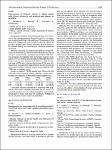Factors associated with DPT 1-3 vaccine dropout in Kabarole district
Date
2010Author
Opollo, M.-S.
Makumbi, F.
Mukanga, D.
Namusisi, O.
Ayebazibwe, N.
Tweheyo, R.
Metadata
Show full item recordAbstract
Background: Among the top ten causes of poor health in
the district are complications due to vaccine preventable
diseases notably diphtheria, pertussis and tetanus (DPT). In 2008, the DPT dropout rate in Kabarole was high (18%). This
study assessed the service, community and individual factors
associated with DPT1-3 dropout in Kabarole District.
Methods: A cross sectional study using cluster sampling
was employed. Two clusters at parish level (rural and urban)
each from a county in the district were selected by sim ple random sampling and all villages therein were studied.
A total of 230 children (115 from either cluster) were
recruited and their parent or guardian interviewed. Cross-tabulations and chi-square tests were used to determine the
strength of associations between independent variables and
the outcome. Binary logistic regression was done to adjust
for potential confounders and identify independent predic tors. Key informant interviews were held with in-charges of
health units. Qualitative data was analysed manually using
thematic approach and results presented in the form of text.
Results: Factors found to be associated with DPT1-3
dropout were; lack of caretaker knowledge about DPT
dosage, (adj. OR = 8.2; 95% CI: 3.12, 21.53); Child’s Birth
Order, 6th and above (adj. OR = 3.0; 95% CI: 0.80, 11.05);
Child Birth Order 2-3 (adj. OR = 2.2; 95% CI: 0.70, 6.71);
Child age group 31-36 compared to 12-18 (adj. OR = 2.5; 95%
CI: 0.81, 7.84). However, Rural residence (OR = 1.2; 95% CI:
0.56, 2.57); and Child without immunisation card (OR = 4.4;
95% CI: 0.35, 39.86) were not significantly associated with
DPT dropout.
Conclusion: The current DPT1-3 dropout prevalence in
Kabarole is still high but dropping (13.7%). DPT 1-3 dropout
is associated with caretaker lack of knowledge of number of
dosages a child should receive and involvement of religious
leaders, long travel distance to point of accessing transport means, and convenient time for immunisation. Findings
from this study can be used to improve DPT immunisation
services. Specific campaigns on DPT immunisation through
home visits, involving community leaders and full day immunisation can help further reduce the dropout rate
Collections
- Research Articles [19]

